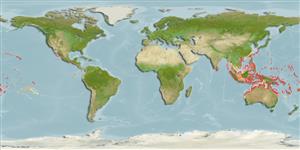>
Eupercaria/misc (Various families in series Eupercaria) >
Scaridae (Parrotfishes) > Scarinae
Etymology: Scarus: Greek, skaros = a fish described by anciente writers as a parrot fish; 1601 (Ref. 45335).
More on author: Bleeker.
Environment: milieu / climate zone / depth range / distribution range
Écologie
marin récifal; profondeur 3 - 30 m (Ref. 9710). Tropical; 30°N - 28°S
Pacific Ocean: Christmas Island in the eastern Indian Ocean (Ref. 30874) to the Pitcairn Group.
Taille / Poids / Âge
Maturity: Lm ? range ? - ? cm
Max length : 55.0 cm TL mâle / non sexé; (Ref. 2334); poids max. publié: 2.5 kg (Ref. 3488)
Description synthétique
Clés d'identification | Morphologie | Morphométrie
Épines dorsales (Total) : 9; Rayons mous dorsaux (Total) : 10; Épines anales: 3; Rayons mous anaux: 9. This species is distinguished by the following characters: median predorsal scales 6-7; 3 scale rows on cheek,1(5-7), 2(6-9), 3(2-5); pectoral-fin rays 13-14 (usually 14); dental plates partially covered by lips and large adult with 1-2 conical teeth on side of upper dental plates; caudal fin emarginate in female and lunate in terminal male. Colour of male green with pink scale edges (pink colour sometimes cover much of the central body), green band around mouth with extension below eye and violet zone on upper head; female generally pale grey with broad zone of yellowish brown on middle of side, a small pale dot above diffuse blue-green patch on mid-side and a dark band from eye to pectoral region (Ref. 9793, 90102).
Often found on exposed outer lagoon and seaward reefs, usually in rich coral habitats. Generally solitary. Feeds on benthic algae (Ref. 89972). In Hong Kong live fish markets (Ref. 27253).
Life cycle and mating behavior
Maturities | Reproduction | Spawnings | Egg(s) | Fecundities | Larves
Oviparous, distinct pairing during breeding (Ref. 205).
Parenti, P. and J.E. Randall, 2000. An annotated checklist of the species of the labroid fish families Labridae and Scaridae. Ichthyol. Bull. J.L.B. Smith Inst. Ichthyol. (68):1-97. (Ref. 35918)
Statut dans la liste rouge de l'IUCN (Ref. 130435)
Menace pour l'homme
Harmless
Utilisations par l'homme
Pêcheries: commercial
Outils
Articles particuliers
Télécharger en XML
Sources Internet
Estimates based on models
Preferred temperature (Ref.
123201): 25 - 29.3, mean 28.4 °C (based on 2187 cells).
Phylogenetic diversity index (Ref.
82804): PD
50 = 0.5000 [Uniqueness, from 0.5 = low to 2.0 = high].
Bayesian length-weight: a=0.02042 (0.01146 - 0.03638), b=2.98 (2.82 - 3.14), in cm total length, based on LWR estimates for this species & (Sub)family-body (Ref.
93245).
Niveau trophique (Ref.
69278): 2.0 ±0.00 se; based on food items.
Generation time: 1.2 ( na - na) years. Estimated as median ln(3)/K based on 1
growth studies.
Résilience (Ref.
120179): Haut, temps minimum de doublement de population inférieur à 15 mois (Preliminary K or Fecundity.).
Fishing Vulnerability (Ref.
59153): Low vulnerability (23 of 100).
Nutrients (Ref.
124155): Calcium = 36.8 [19.1, 93.0] mg/100g; Iron = 0.823 [0.450, 1.429] mg/100g; Protein = 18.4 [16.2, 20.3] %; Omega3 = 0.0673 [, ] g/100g; Selenium = 26 [13, 52] μg/100g; VitaminA = 18.5 [4.2, 80.6] μg/100g; Zinc = 1.76 [1.16, 2.65] mg/100g (wet weight);
